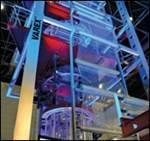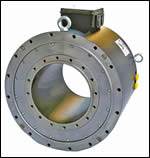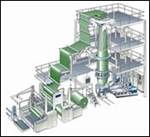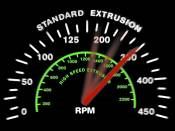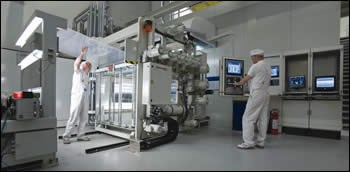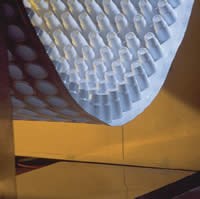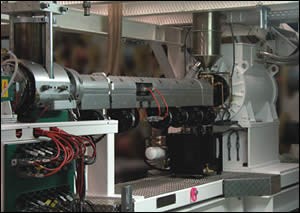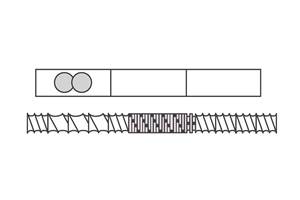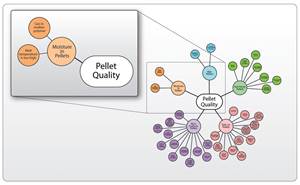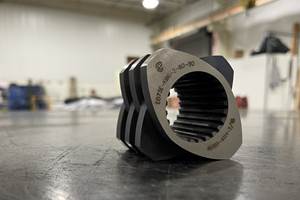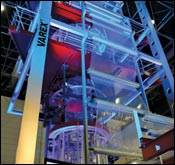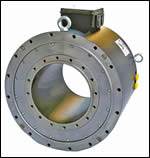High-Speed Extrusion: Are You Ready for the Fast Lane?
Around three dozen, mostly European, processors are pushing commercial development of high-speed single-screw extrusion. They have installed more than 100 of the small hyper-drive machines whose screws turn at up to 1500 rpm, about eight to 10 times faster than standard extruders. At least two German machine builders are working on machines that will go to 2000 rpm and even higher. The goal is to raise output without increasing extruder size.
These machines are long, thin, and cool to the touch. They’re the Ferraris of extrusion, and they scream—literally. At the highest rpms they hum at unusual frequencies. That drove one user to enclose the machine in a separate room, even though it was below EU noise limits of 80 dbA.
So far, these souped-up machines have processed a limited range of materials—mainly polystyrene, polypropylene, and ABS, plus a little polyethylene—all of them typically unfilled or lightly filled. Each resin requires a different optimized screw.
Machine wear at these hyper speeds is a potentially important unknown, since the phenomenon is so new. Only two motors are known to have burned out on the job, and both were on early prototype machines.
ENERGY & SPACE SAVINGS
European processors bought the first high-speed extruders five years ago to make PS and PP sheet for in-line thermoforming. Their main goals were energy and space savings, neither of which were comparable concerns for U.S. processors.
Users say the high-speed machines provide energy savings of 10% to 15%. The savings come from not heating or cooling the mass of metal in the extruder barrel and not losing energy in gear reduction. High-speed extruders use heater bands sparingly or not at all. Most high-speed extrusion is done in-line with thermoforming. Those extruders run at 400 to 800 rpm and typically feather the heater bands on and off. Machines producing sheet off-line run at 900 to 1500 rpm and use heater bands only on start-up. Thereafter, plastic is melted entirely with frictional heat. In both cases, the barrel stays cool to the touch, so no cooling is needed, except perhaps in the feed zone.
At top screw speeds, energy consumption actually drops even while output goes up. “When running PS and PP at over 750 rpm, as you go up in speed, you go down in specific energy consumption,” notes Rainer Bobowk, divisional manager of flat film and sheet at Kuhne GmbH in Germany (represented here by American Kuhne).
High-speed extruders also save energy by dispensing with gear reducers. These machines either have motors directly coupled to the screw or use a 1:1 gear ratio.
Most high-speed extruders fall between 60 and 75 mm diam. and none are larger than 90 mm. Kuhne offers only 60- and 72-mm sizes with 33:1 L/D. Battenfeld Extrusionstechnik (BEX) found 75 mm diam. and 34:1 to 40:1 L/D to be the optimum for the biggest output advantage. Below 75 mm, machine builders cannot take full advantage of potential screw flight depth without risking breakage at high rpm. Above 75 mm, they lose the adiabatic effect and have to add heat and cooling.
The small size of high-speed machines allows a crowded plant to expand production within its existing footprint. Five years ago, Bartling GmbH in Borgholz-hausen, Germany, installed the first pilot high-speed machine from BEX (represented here by American Maplan) and later one of the first from Kuhne. The goal was to increase output in an industrial zone where expansion was difficult. “It was the best extrusion decision we ever made,” says Axel Bartling, principal of Bartling GmbH, which thermoforms PP margarine tubs inline. “Because the machines are so small, we can shut them down and start them up very easily.”
Color changes on small machines are also faster and waste less plastic. Faerch Plast in Holstebro, Denmark, last year was the first to extrude PP sheet at 1500 rpm. It runs black, blue, white, and clear sheet for thermoformed food trays on its 75-mm BEX extruder. Because the screw holds only 4 kg of resin (vs. 40 kg for a 150-mm extruder of the same output), Faerch says it can change from black to clear in about 1 hr, vs. 1.5 hr on a conventional extruder. Changing from clear to black takes 3 min.
Huhtamaki Oyj, headquartered in Finland, is believed to own more high-speed extruders than any other processor. It installed more than 10 of them to reduce energy cost and to enable inline sheet extrusion and thermoforming in plants where space is limited. Huhtamaki runs Kuhne 72-mm high-speed extruders for rigid PP and PS inline thermoforming in Siemianowice, Poland, and BEX 75-mm high-speed models on barrier sheet lines in Auneau, France. In the Polish plant, Kuhne installed small high-speed extruders facing backwards on mezzanines over the roll stacks with two 90°-angle pipes to reach the die.
HISTORICAL ROOTS
European thermoformers have an historic connection to high-speed extrusion. Thyssen Plastikmaschinenbau in the 1970s built 90-mm extruders for Bellaplast in Germany to make PS sheet at up to 450 rpm and 2600 lb/hr. Thyssen Plastikmaschinenbau was acquired by BEX in 1980, and its high-speed extruder development stalled. “The extruder builders had the attitude, ‘Why should I sell a customer a small machine when I can sell them a big one?’” says the head of technology at one German machine builder. “Then BEX broke ranks and began building small, high-speed models again, so we all said, ‘We can do that too.’”
High-speed extruders are now developing so rapidly that it’s hard to define high speed anymore. Traditionally, any rotation of screw circumference over 1 meter/second was high speed, but top rotational speeds today are 3, 4 and 5 m/sec.
In the U.S., development of high-rpm single-screw extruders took a different route—making color masterbatches instead of sheet for thermoforming. The objective was rapid mixing and color changes, not higher output. In the 1960s, Prodex in New Jersey built two 2-in. extruders that ran at 1000 rpm for making PP color concentrates. Prodex later became part of HPM. In the mid 1990s, HPM began building 2-in. to 4.5-in. extruders with up to 50:1 L/D for pelletizing color concentrates. These used HPM’s patented Triple Wave screw and ran at 800 to 1000 rpm. The 2.5-incher with a 500-hp motor extrudes 2400 lb/hr of HDPE at 850 rpm. HPM’s 3.5-in. (90-mm) model runs at up to 500 rpm.
Though this article focuses on single screws, it’s worth noting a trend to higher-speed corotating twin-screw compounding extruders since the early 1990s. A number of machines today run at up to 1200 rpm and some even go to 1800 rpm.
EARLY REPORT CARD
The new generation of European high-speed single-screws has been running for one to four years in 24/7 operations. Processors’ most startling discovery is that besides energy and space savings, high-speed extruders actually improve sheet clarity. In particular they improve clarity and crystalline structure of PP sheet. The traditional approach to making thin PP sheet is with slow, controlled cooling. But high-speed extrusion requires faster cooling.
Faerch Plast experimented with cooling-roll temperatures in offline PP sheet extrusion and found that thin-wall cooling rolls, combined with a screw tailored for high rpms, improved the crystalline structure of PP sheet. “Higher clarity is a result of the combination of the high-speed screw and new optimized cooling,” says Frank Ostervemb, innovation manager at Faerch Plast. (Huhtamaki also says it gets higher-quality PP sheet with its inline high-speed extrusion.)
Large-diameter, thin-walled cooling rolls are the norm in the U.S. but are newer in Europe. In the past year, two German roll builders developed such thin-wall rolls for high-speed extrusion. Derichs Maschinen- und Apparatebau GmbH and Josef van Baal GmbH introduced thin-wall rollers using six or eight spiral cooling channels instead of the usual four to give strength and rigidity to the roller. That allows the hard casing to be made of half-inch steel instead of the typical (in Europe) 1 in., providing 20% to 40% faster heat transfer.
BEX has built the first model of a new roll stack designed for high-speed extrusion. Smaller and faster than a conventional stack, it is expected to debut at the K 2010 show in Dusseldorf.
High shear forces result in a PP melt temperature at the end of the high-speed extruder that is generally a few degrees F higher than at the end of a conventional extruder. Shearing at high rpms also lowers PP’s melt viscosity more than usual. But after a lot of testing, Faerch Plast established that high screw speeds don’t hurt the sheet’s impact properties.
Another surprising discovery about high-speed extrusion is that PS, ABS, and other resins degrade less in a high-speed extruder because of dramatically shorter residence time. Clear PS sheet has better color, says Peter Rieg, BEX product manager for film and sheet technology. BEX has a Dutch customer extruding APET sheet at up to 800 rpm and 2200 lb/hr. This customer reportedly sees less degradation of the APET at high speed. Trials with PLA biopolymer also show less thermal degradation, and sheet comes out with a blue not yellow cast, says Rieg.
Sheet for non-packaging applications is also being made in high-speed extrusion. Alma Polska Wroclaw Sp.z.o.o. in Poland is believed to be the first to do high-rpm extrusion of sheet for durable applications. Alma installed a BEX 75-mm extruder in February this year to make white ABS and PS sheet from 1 to 6 mm thick for refrigerator liners at over 3000 lb/hr. Alma is said to use a conventional ABS screw.
Some pioneers are starting to run LDPE at moderately high screw speeds and very high outputs. There are a half-dozen high-speed extruders running LDPE stretch film. The first has run for almost two years at Manuli Stretch in Schkopau, Germany.
There are also pioneers in pipe. In 2006, Cincinnati Extrusion in Austria sold a prototype 60-mm, 37:1 extruder with a standard DC motor and two-stage gearbox to Rehau AG in Viechtach, Germany, for making PP pipe. But Rehau had trouble with gearbox noise and high melt temperatures at high rpm. Rehau now uses the machine at normal speeds of about 100 rpm, getting output of 880 lb/hr, not the originally intended 3500 lb/hr.
At the K 2007 show in Germany, Cincinnati Extrusion introduced a commercial version of this extruder, called Rapidex 1500. Unlike the earlier prototype, this model has an Oswald permanent-magnet, synchronous torque motor attached directly to the screw. Cincinnati has delivered two of these machines with guaranteed outputs of 3190 lb/hr of HDPE pipe up to 1200 mm diam. at 800 rpm—equaling the output of a 150-mm extruder three meters longer. High-speed extrusion of HDPE is not affected by backpressures up to 700 bar, Cincinnati says. The firm is also introducing new high-speed pipe cooling technology that reportedly will double output in a given cooling length.
Amut SpA in Italy has delivered two of its GLE 9000 HS high-speed extruders for running PE and PP pipe at 400 and 700 rpm, respectively.
Coextruded cast film is another new frontier for high-speed extrusion. Besides Huhtamaki’s barrier film line in France, EDV Packaging in Llinars del Valles, Spain, extrudes cast coex barrier PP and PS film at high speed on a line installed last year. EDV declined to provide details.
HIGH-SPEED SCREW DESIGN
High-speed extruder screws need a longer melting section and higher L/D (typically 30:1 to 40:1) to get more output at the same screw speed. Kuhne’s high-speed 72-mm screws process 3750 lb/hr of PS or 3570 lb/hr of PP at 1000 rpm. At 800 rpm, they extrude 3500 lb/hr of PLA or 3000 lb/hr of APET.
Kuhne first explored high-speed extrusion in the early 1990s, when Kurt Huth, then managing director of Optipack, revved up a standard 120-mm extruder to 450 rpm, raising throughput from 800 kg/hr of PS sheet to 2600 kg/hr. At the end of a year, the gearbox was destroyed, but the firm learned a lot about high-speed screw design, Kuhne’s Bobowk recalls.
For BEX, the learning period was a year of development with Faerch Plast. When Faerch first installed BEX’s precedent-setting 1500-rpm extruder in 2006, it generated too much shear at high speeds. After a year of optimization, it now produces 3000 lb/hr of PP sheet at 1500 rpm.
BEX calls the design a “modified five-zone barrier screw,” but the five zones are not the ones you might expect—feeding, melting, mixing, venting, and metering. Instead, it has zones for feeding, melting, land/restrictor, venting, and metering. The unusually long feeding and melting zones (without barrier flights) occupy roughly two-thirds of the screw. The feed section for PP has deeper flights tapering to a shallow land that is perfectly smooth with no flights at all. This lets plastic pass at higher speed with less torque. Next is a restrictor zone, which consists of a barrier element for PP (not used for PS), followed by conventional venting and metering zones.
Note the absence of a mixing zone. “Nobody has ever found a dynamic mixer that can accommodate the high-speed range,” says Huth, now principal of Plastconsulting in Germany, which specializes in high-speed extrusion. Mixing is done by turbulence alone. Faerch mixes colorant and additives into PP at up to 1500 rpm. “We slowed down at first, but mixing turned out not to be a problem because there is a lot of polymer turbulence at 1500 rpm,” says Carina Nielsen, project manager at Faerch Plast.
Screw alignment at speeds over 800 rpm is critical. Kuhne’s high-speed screw is modified with more clearance in the feed zone, so higher feed rates don’t cause the screw to deflect. Kuhne uses a conventional smooth-bore screw with an elongated melting section, but adds barrel heating and air cooling to control high temperatures in the feed zone.
“If the screw has been optimized for high speed, you can run without cooling,” says Huth. “If it’s not optimized, you need cooling.”
Use of scrap was initially an issue for high-speed extrusion, until screws were deepened in the feed zone. Bartling says it can blend in 50% PP regrind from thermoforming skeletons. Faerch can blend up to 70% regrind.
After the high-speed extruder comes a screen changer, then a gear pump, and then a long static mixer for temperature homogeneity. The mixer has multiple probes to monitor temperature closely (especially for PP). “It’s important to get the material all melted,” says Faerch’s Ostervemb. “You don’t want to use the screen packs to handle the last unmelts.”
Screen changers have to be enlarged to match higher throughputs. Both screen changers and gear pumps should be supported so that their weight doesn’t cause screw deflection, Kuhne notes.
WHO BUILDS WHAT
High-rpm single-screw extruders appeared as new technology for thin sheet at the K 2004 show (see Learn More box above). Since then BEX has delivered 25 machines to run at 400 rpm and more than 50 to run at 600 to 1500 rpm.
HPM has delivered over 30 2- and 2.5-in. extruders for 700 and 850 rpm, respectively, and over 20 3.5-in. (90-mm) units for up to 500 rpm. One was for sheet and the rest for color concentrates.
Kuhne has delivered over 20 extruders to run at 400 to 800 rpm. SML Maschinengesellschaft in Austria has delivered 10, including four 90-mm extruders for PS/PP forming film and six for LDPE stretch film (over 2200 lb/hr at 400 rpm).
Welex Inc. has delivered one high-speed model for thin sheet to the Middle East. Esde Maschinentechnik GmbH in Germany delivered 27 units built for more moderate speeds of 380 and 450 rpm.
Two machine builders have built high-speed extruders for pipe. Cincinnati Extrusion has delivered two 800-rpm pipe extruders. Amut delivered two for running pipe at up to 700 rpm.
What are the prospects for high-speed extrusion in the U.S.? Stretch film is a good bet since that market is so competitive and undergoing consolidation. The U.S. has concentrated on downgauging to reduce cost, so the next step will have to be higher output with faster winding. High-speed extruders also could be adopted for inline thermoforming of yogurt cups and coffee lids. “If someone wants to increase output with a limited plant footprint, high-speed extrusion is the way to go,” notes Kurt Waldhauer, president and CEO of American Maplan, which represents sister company BEX.
Better quality and color in sheet may also be a draw for high-speed extrusion, especially as screw designs improve for resins like PLA and PET. “We’re just beginning to test what is possible with other materials,” says Kuhne’s Bobowk. “It’s very early in the R&D.”
Related Content
Configuring the Twin Screw Extruder: Part 4
For many compounding operations, material is fed to the extruder at the feed throat. This is the case when feeding a single polymer or a blend of polymers mixed with solid additives. Some ingredients, however, present a challenge in feeding. Here’s how to solve to them.
Read MoreWhat to Know About Your Materials When Choosing a Feeder
Feeder performance is crucial to operating extrusion and compounding lines. And consistent, reliable feeding depends in large part on selecting a feeder compatible with the materials and additives you intend to process. Follow these tips to analyze your feeder requirements.
Read MoreThe Path to Pellet Perfection
In underwater pelletizing, numerous variables in the equipment, process and material affect pellet shape, consistency and quality factors such as fines. Defining the “perfect” pellet depends on the conditions of end use, and achieving that ideal requires understanding of the causes of imperfections.
Read MoreHow to Configure Your Twin-Screw Extruder for Mixing: Part 5
Understand the differences between distributive and dispersive mixing, and how you can promote one or the other in your screw design.
Read MoreRead Next
K 2007 Extrusion: Extrusion Outputs Go Through the Roof
Dramatic production demonstrations of cast and blown film set throughput records on the show floor in Dusseldorf.
Read MoreShhh ... Can You Hear the New Extruder Motors?
Silent, space-saving, energy-efficient, and high-torque, a new generation of ring-shaped motors is gaining a foothold in extrusion. A couple of hundred are already in use. Though most machine builders are reacting cautiously, adventurous processors are using them happily.
Read MoreK 2004 News Preview: Extrusion
At K 2004, at least a half-dozen European machine builders will show new direct-drive extruders running gearless—or nearly gearless—drives with substantially higher rpm and output rates than conventional extruders of the same size.
Read More
